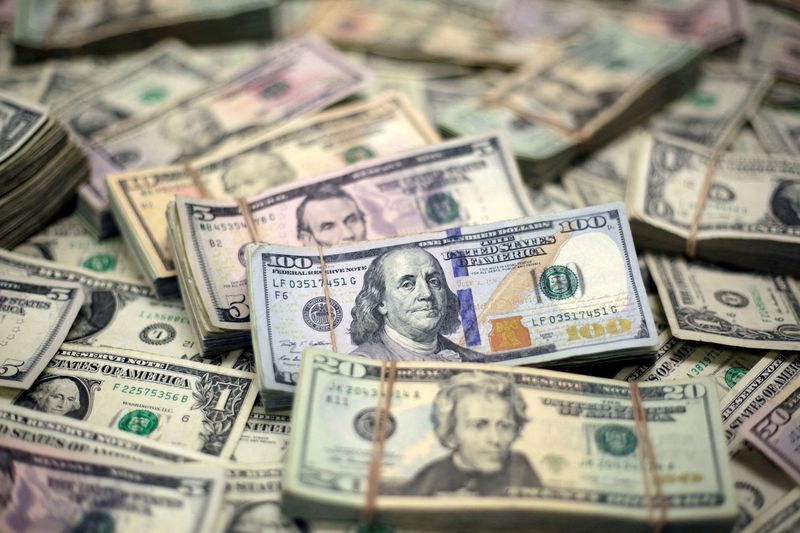By Jamie McGeever
ORLANDO, Florida (Reuters) – U.S. Treasuries may not be quite as risk-free as they once were, and the dollar’s stranglehold on global currency reserves may have loosened, but talk of their demise remains extremely premature.
Politicians, investors, and even officials at the Kansas City Fed’s Jackson Hole Symposium last week, have debated whether the ballooning U.S. government debt pile is threatening the country’s safe-haven status.
But America’s ‘exorbitant privilege’ – that is, the U.S. dollar’s status as the world’s reserve currency – continues to enable the U.S. government to borrow eye-popping amounts at relatively low cost.
And the fact remains that no other government debt market or currency comes close to rivaling U.S. Treasuries and the dollar for liquidity and safety. It’s tough to see how this could change, meaning the doomsday reckoning of a U.S. debt and dollar crash remains a distant prospect.
DANGER AHEAD?
That’s not to totally dismiss concerns about the path of U.S. fiscal policy.
Public debt is now around 100% of GDP and rising. It is projected to breach the current record of 106% of GDP within three years, according to the non-partisan Congressional Budget Office, and reach 122% of GDP by 2034.
That will equate to annual deficits of almost $2 trillion or nearly 7% of GDP, well above the 3.7% average seen over the past half century. You don’t have to be a ‘doomer’ or even a mild Cassandra to see warning signs here.
But that’s where the privilege kicks in. Research this week published by the University of Toronto’s Jason Choi, the University of Wisconsin-Madison’s Rishabh Kirpalani and Duong Dang, and New York University’s Diego Perez highlights the extent of America’s ‘exorbitant privilege.’
In their report ‘Exorbitant privilege and the sustainability of U.S. public debt’ they note that this special status “increases the maximal sustainable debt by approximately 22% of GDP.”
In other words, the U.S. government can sustainably borrow as much as 22% of GDP more than it would otherwise be able to if it weren’t the supplier of the global reserve currency.
With U.S. GDP currently around the $27 trillion mark, that 22% equates to around $6 trillion of extra debt that Washington can issue on a sustained basis at safe rates without significantly increasing the risk of default.
Most of this extra headroom is due to the ‘convenience yield’ offered by Treasuries. In other words, investors benefit from Treasuries’ liquidity and use as collateral and are willing to accept lower yields as a result.
Today’s rates market seems to support this theory. The U.S. Treasury is currently borrowing record amounts – more than half a trillion dollars in bills and bonds this week alone – yet yields across the curve are near their lowest levels this year.
UNASSAILABLE DOLLAR
With so much debt being issued, it’s fair to ask who will continue to buy and at what price? For much of the period between 2000 and 2020, foreign central banks were the main source of demand for Treasuries. This raised concerns that the Treasury market could falter if foreign central banks reduced their purchases and holdings.
But these fears have turned out to be unfounded. Foreign central banks’ share has fallen, but overseas private sector investors, domestic U.S. funds, and the Fed itself have filled the gap. The Treasury market continues to function smoothly and act as a fundamental bedrock of the global financial system.
Similarly, there is little sign of the dollar collapse that some of the more over-caffeinated analysts have warned would inevitably come as central banks diversified their FX reserves holdings.
True, the greenback may currently be at a 2024-low, but turn back the clock a couple of years, and it was at a 20-year high.
And even though it accounts for less than 60% of global reserves today compared to more than 70% at the turn of the millennium, it is losing ground to currencies with tiny shares like the Australian and Canadian dollars, South Korean won and Nordic currencies, rather than its only viable rival, the euro.
Nothing stays the same forever. Just ask the UK, whose currency dominated global markets for over a century only to be eclipsed by the greenback. But investors seeking security, liquidity and safe returns are likely to continue putting their trust in U.S. Treasuries and the dollar – because, at least for now, there is no alternative.
(The opinions expressed here are those of the author, a columnist for Reuters.)
(By Jamie McGeever; Editing by Andrea Ricci)

